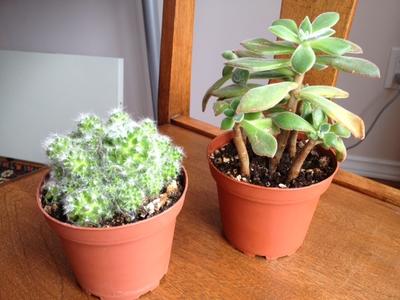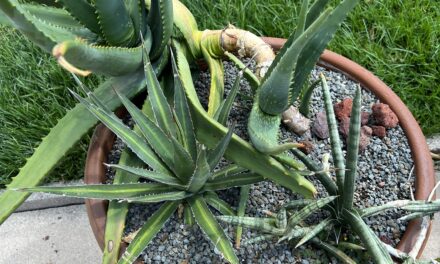by Kenzie
(Alberta, Canada)





I have number of succulents/cacti I have collected in the last year, however they are all reaching sizes that lead me to believe they should be repotted.
Before I start messing around with them I was hoping to get a bit more info, like if I can split a plant into two pots (the little fuzzy palm tree looking one specifically) or if that would damage the root system.
Also, the cactus with the yellow spikes seems to be sprouting a blossom and I was wondering if I should adjust the watering/care for the plant if that occurs.
And just generally I was wondering what the little bulbous cactus is as well as the pale succulent.
Thanks so much!
Kenzie
Hi Kenzie, what a great little collection! I’ll see if I can give you some idea of names or at least something close that is likely to need the same kind of care.
a & b) This looks to be some kind of smaller Mammilaria cactus, and the palm tree looking one is Echeveria set-oliver or one of the other hybrids that are closely related.
All cactus, regardless of the genus and species, resent low light levels and too much water.
Keep them on the dry side, and then periodically, twice a year, water them copiously.
This is what happens in their native habitat; months and even years of drought are followed by torrential rainfall over the course of a few days.
This is what triggers abundant flowering, always a good feature of growing cacti.
For the palm tree plant, you may be best to simply behead it; cut each rosette off the tall stem, just below the topmost good leaves. Set it on some DRY potting soil.
Don’t water it, just let it callous for at least a week.
Then you can spray the surface of the soil. This makes them think they are in the desert, and the spraying reminds them of dew.
The roots will start to seek out moisture, and then once the cutting is securely rooted, you can start them on a regular watering schedule.
c) Cactus of unknown genus; sorry, I’m not that knowledgeable about the different kinds. Don’t repot this until it finishes blooming, because they’re apt to drop the buds if they’re disturbed.
Afterwards, you can separate the different plants, or just keep them in a group, and put into a bit bigger pot.
Don’t overpot them, or it could be years before they bloom again. They like to be a little bit crowded. The thought here is that it stresses them out a bit, and that will trigger bloom if you follow the same instructions as for the Mammilaria cactus, a & b, above.
d) This is a lovely blue Echeveria, and again, there are so many different ones that it’s almost impossible to pin down exactly which one this is.
It looks a bit like E. ‘Perle von Nurnberg’ but also has a bit chubbier leaves more like some of the others. Sorry to be so vague, but growing them in different conditions can make them have a completely different appearance.
So, you can see more about each of these kinds of plants here:
Hope that helps with your increasing collection!
Jacki



